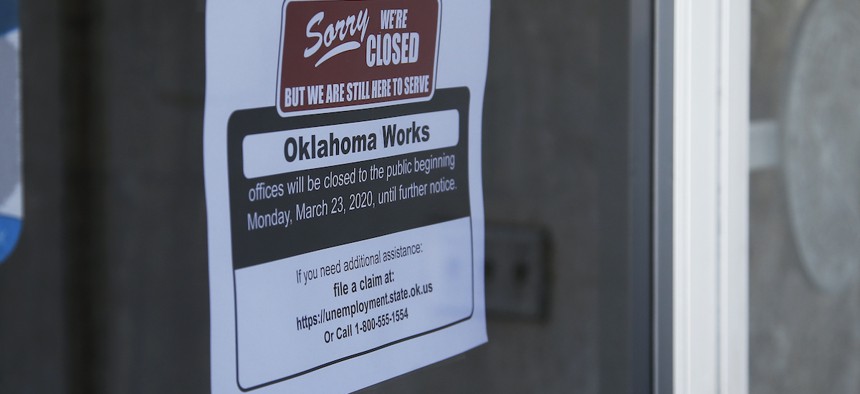Government Telework Was Already on the Rise. Then Covid-19 Happened.

A sign at the Oklahoma Employment Security Commission offices states the offices are closed, Thursday, April 23, 2020, due to the coronavirus, in Oklahoma City. Associated Press

Connecting state and local government leaders
Increasing numbers of state and local government employees were teleworking last year, a trend that seems likely to continue after the coronavirus pandemic, according to new research.
An increasing number of state and local government employees were already teleworking before the coronavirus pandemic, a trend that seems likely to continue in the coming years, according to research released this week by the Center for State and Local Government Excellence.
“The percentage reporting regular telework for eligible positions (27%) is the highest share reported since this question was added in 2016, with the practice more common in state agencies than local ones,” says the State and Local Government Workforce: 2020 Survey, an annual study on state and local workforce issues that collects information from human resources departments across a variety of government agencies. “This increase may relate to the initial response to Covid-19, which overlapped with the conduct of this survey.”
The survey, conducted in partnership with the International Public Management Association for Human Resources and the National Association of State Personnel Executives, compiled responses from 222 HR employees (77% from local governments, 17% from state agencies, and the final 6% from the federal sector, which were excluded from the final results). The online survey ran from Feb. 27 through April 7, and while the results generally refer to activity over the past year, some responses also reflect the beginning of ongoing workplace changes influenced by the pandemic, said Gerald Young, a senior research associate for the nonprofit research organization.
"This survey will be an increasingly important baseline as the Covid-19 crisis continues to unfold," he said. "Overall, the data show a continuation of recent workforce trends, but we anticipate dramatic swings in future years.”
For example, more than three quarters of respondents had hired employees in the past year, while only 5% had instituted layoffs and just 3% had furloughed workers. But that picture is likely to change dramatically as governments take stock of reduced tax revenue because of the pandemic and business closures. Some jurisdictions have already cut staff in the wake of the coronavirus outbreak, and more layoffs and pay cuts are expected. The brunt of those impacts may not fully hit state and local governments for years, Young said.
“As we look at the surveys that we did at the last recession, 2009 did not see significant changes in a lot of those factors,” he said. “A lot of the financial impact on state and local governments happened later, in 2010, 2011 and 2012. Pay freezes were more common early on, as were hiring freezes, but the furloughs, changes in numbers of authorized positions and the changes in the services they were providing really happened much more as the recession was ending for a lot of private businesses.”
Looking past the current crisis, long-term changes to flexible work policies, including the option to work remotely, are likely to accelerate. Twenty-seven percent of respondents said regular telework was available for eligible positions, which typically exclude jobs that relate to public safety, public works and parks, among other departments. Telework was also more common in larger state agencies (64%) than in smaller local governments (19%).
But an increasing number of respondents—42%, up from 25% in 2015—said the creation of a more flexible workplace was a priority. During the pandemic, governments of all sizes have been forced to embrace some type of telework, and that trend seems likely to continue, Young said, particularly in agencies where administrators had been hesitant to allow telework for fear of reduced productivity.
“There’s always been that consideration, for some organizations, that they need to be able to see their employees. They feel the need to walk around and see the work being performed,” he said. “I think this experience that we’re going through right now is giving everybody an experiment in that, and it seems likely that as we come away from this, that it will continue, in some form, in every size of organization.”
In the coming weeks, Young said, the nonprofit hopes to conduct follow-up surveys with government employees to get a sense of the daily changes and challenges occurring across agencies and jurisdictions.
“This survey is human resource directors, but we want to capture the employee opinions as well,” he said. “We want to see what they’re going through, whether it’s additional stresses on the job, changes to workload, or challenges to getting their work done.”
Kate Elizabeth Queram is a Staff Correspondent for Route Fifty and is based in Washington, D.C.

NEXT STORY: Work From Home Is Here to Stay




